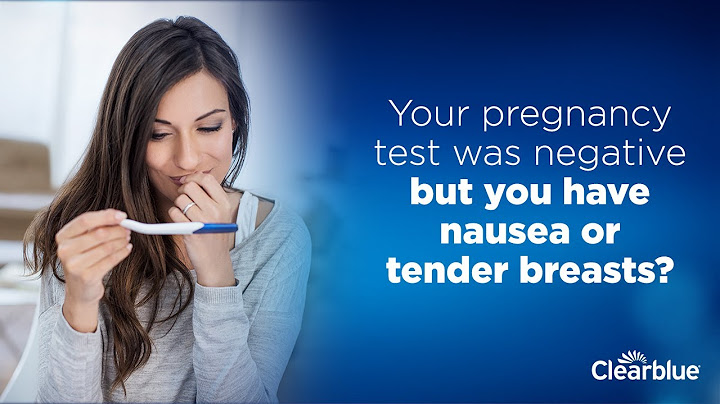No matter what, taking a pregnancy test can be an emotional roller coaster. When it comes to getting a false positive pregnancy test result, the experience can be deeply upsetting, particularly for anyone who has had a difficult time getting pregnant or is actively hoping to get pregnant (or both). The hope that comes with seeing that positive sign crashing down as you realize it was a false positive pregnancy test? It's a uniquely devastating emotion. Show
Of course, getting a false positive pregnancy test when you’re actively trying not to get pregnant can be just as horrible. Yup, you could probably do without the panicked verification trip to the ob-gyn, just to learn there was nothing to stress over. Thankfully, experts note that false positive pregnancy tests are rare. Unfortunately, though, they can happen. Here are some of the most common causes of a false positive pregnancy test, along with some additional information that can help you put it all into context. First, what is a pregnancy test?Let's start with the absolute basics just to make sure we're all on the same page. A pregnancy test tells you if you’re pregnant or not. That's simple enough to understand. But it's understandable if you're a little fuzzy on the details of what these devices actually look for to identify a pregnancy. At-home pregnancy tests check for the hormone hCG. HCG is short for human chorionic gonadotropin, which the body creates during pregnancy. Right after a fertilized egg attaches to the uterine lining, the placenta then forms and starts producing hCG1. A blood test can detect hCG about nine days after conception, and a urine test can detect it 12 to 14 days after conception, according to the Cleveland Clinic, although it varies—some especially sensitive urine tests can detect a pregnancy even earlier. A person’s hCG level typically doubles every 72 hours through 8 to 11 weeks of pregnancy. Then it remains consistent and starts to go down after delivery. Back to top. How does a pregnancy test work?An at-home pregnancy test is designed to find hCG in pee2. If the hormone is present, it triggers a chemical reaction and the test signals that you're pregnant. If hCG is not present, the test will say you aren't pregnant. Many tests use two lines to mean you’re pregnant and one line to mean you’re not—but it depends on the test brand. Some tests use plus and minus signs. Some digital pregnancy tests have a screen that plainly reads "pregnant" or "not pregnant." Which can save you some “Is that one line or two?!” squinting, at least. Seems simple, right? As Ina Garten would say, "How easy is that?" Typically, pretty easy. Most at-home pregnancy tests claim to be about 99% accurate3. Ultrasounds typically can't detect a pregnancy until a little later in your pregnancy and that's why at-home tests are so useful. But, sometimes, other elements can mess with a pregnancy test's results and tell you you’re pregnant when you’re really not. Back to top. What can cause a false positive pregnancy test?Here are the most likely reasons you may end up with a false positive pregnancy test: 1. You let the test sit too long before looking. If you take a standard pregnancy test with line indicators, it's important to check the results according to the specific instruction of the test. If you let it sit too long before reading the results, urine on the test can evaporate and make it look like you have two lines instead of just one. "Oftentimes people will see evaporation lines as urine starts to evaporate off the test," Jamil Abdur-Rahman, M.D., board-certified ob-gyn, tells SELF. That might cause the test to look like it has a faint second line—making it positive—but it really only has one. The best way to avoid this: Read the pregnancy test's directions and follow them exactly. The popular pregnancy test brand First Response, for example, instructs users to wait three minutes after taking the test, then read it as soon as possible4. 2. The pregnancy test is expired. The second most common reason Dr. Abdur-Rahman's patients get false positives is because the test is expired, he says. When a test is past its expiration date, the chemical that detects hCG doesn't always work as it should, and you’re more likely to get a misread. "The test can expire and the chance of having a false positive increases," Dr. Abdur-Rahman says. 3. You’re on fertility medications that raise hCG levels. If you take a pregnancy test too soon after taking a fertility drug that contains hCG—like some injections that are often part of in vitro fertilization—you could get a false positive.  Updated Jul 28, 2022 | By Heidi Tian At home urine pregnancy tests are the most convenient and widely used tool to find out if you are pregnant. They work by detecting human chorionic gonadotropin (hCG), which is a hormone produced during early pregnancy. Unfortunately, you may occasionally receive a false positive pregnancy test result. According to a survey, there is a 1% chance to receive a false positive result. Although a low probability, the result could be misleading and confusing. Here, we would like to share with you 5 common causes to help you be more confident when interpreting your test results. 1. Evaporation LinesIf a pregnancy test is left out for longer than the recommended read time, there may be a slight T line discoloration called an "evaporation line", which resembles a positive pregnancy test. It is critical for users to follow the instructions exactly while taking the test. Take Easy@Home pregnancy tests as an example, it would be recommended to read your result in 5 minutes for an optimal accuracy rate. 2. Chemical PregnancyA chemical pregnancy occurs if a fertilized egg, known as the embryo, is unable to implant or grow. This can happen for a wide range of reasons, such as fibroids, scar tissue, low progesterone, or a congenital uterine anomaly that causes an irregularly shaped uterus. 3. Recent Miscarriage or AbortionAfter an abortion or miscarriage, the level of hCG starts to decrease, but very slowly. Typically, hCG declines over a period ranging anywhere from 9 to 35 days. The average time frame is around 19 days. Taking a pregnancy test within that period can result in a false-positive test. 4. MedicationsIf you’re undergoing fertility treatment, your doctor may prescribe a synthetic hCG trigger shot under brand names like Novarel, Pregnyl, Pergonal, Ovidrel, or Profasi, which helps follicles release mature eggs. Unfortunately, these can also lead to a false positive result. Other medication that can cause a false positive result include -- but are not limited to:
 5. Medical ConditionsCertain medical conditions can cause a woman’s hCG level to increase and trigger a positive result while she is not pregnant. These include, but are not limited to:
You may wonder how to distinguish a false positive from a true one. It is easier than you'd think. Keep taking tests every few days. If the T line gets darker, then you are likely seeing the doubling of the hCG hormone levels, which occurs with early pregnancy. If not, you may be getting a false positive. Next Step:A positive at-home pregnancy test result should always be followed up with a doctor’s appointment. Your doctor may give you a blood or urine test to confirm the results and monitor your hCG levels. If you’ve received a false positive, your doctor’s visit will determine that, too. Some early pregnancy and implantation symptoms may also be good indicators for you to tell if you are really pregnant. These signs of implantation could be also a great information for your medical service provider to make an accurate diagnosis of your condition. Remember that false positives do happen but they are not a sign you’ll never get pregnant. Have faith and keep testing!  Resources:https://www.thesource.org/post/reasons-your-pregnancy-test-gave-a-false-positive Is it possible to get positive in pregnancy test but not pregnant?Could a positive result be wrong? Although rare, it's possible to get a positive result from a home pregnancy test when you're not actually pregnant. This is known as a false-positive.
What causes a false positive pregnancy test?A test will only show a false positive if you have hCG in your system for another reason such as you were recently pregnant, are taking fertility medications containing hCG, or if you have a medical condition, like some rare ovarian cysts.
How rare is it to get 2 false positive pregnancy test?“False positive pregnancy tests are rare and occur less than 1 percent of the time,” confirms DuMontier. Generally speaking, there will be a contributing factor if you're seeing a false positive pregnancy test. If not, you can assume the test you've used is faulty in some way.
|

Related Posts
Advertising
LATEST NEWS
Advertising
Populer
Advertising
About

Copyright © 2024 en.frojeostern Inc.

















